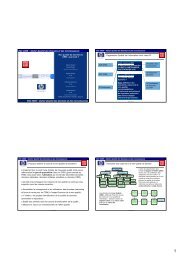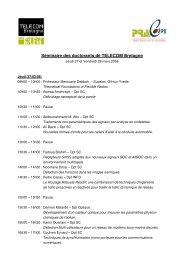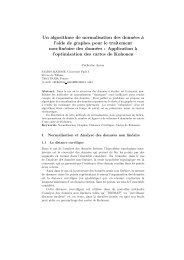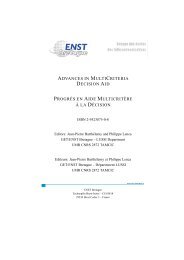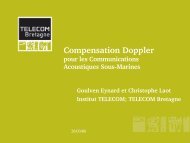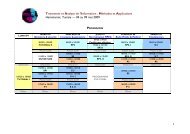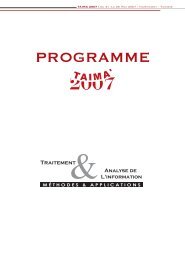A finite time stochastic clustering algorithm
A finite time stochastic clustering algorithm
A finite time stochastic clustering algorithm
You also want an ePaper? Increase the reach of your titles
YUMPU automatically turns print PDFs into web optimized ePapers that Google loves.
A <strong>finite</strong> <strong>time</strong> <strong>stochastic</strong> <strong>clustering</strong> <strong>algorithm</strong><br />
Andreea B. Dragut 1 and Codrin M. Nichitiu 2<br />
1 LIF, Univ. Aix-Marseille II, Aix-en-Provence, France<br />
2 Long Island High Tech. Incubator, Stony Brook Univ., NY, USA<br />
Abstract. We present a <strong>finite</strong> <strong>time</strong> local search (1 + δ)-approximation method<br />
finding the optimal solution with probability almost one with respect to a general<br />
measure of within group-dissimilarity. The <strong>algorithm</strong> is based on a <strong>finite</strong>-<strong>time</strong><br />
Markov model of the simulated annealing. A dynamic cooling schedule, allows the<br />
control of the convergence. The <strong>algorithm</strong> uses as measure of within group dissimilarity<br />
a new generalized Ward index based on a set of well-scattered representative<br />
points, which deals with the major weaknesses of partitioning <strong>algorithm</strong>s regarding<br />
the hyperspherical shaped clusters and the noise. We compare it with other <strong>clustering</strong><br />
<strong>algorithm</strong>s, such as CLIQUE and DBSCAN.<br />
Keywords: Clustering, Finite-<strong>time</strong> Simulated Annealing, Approximation Scheme,<br />
Generalized Ward Index.<br />
1 Introduction<br />
It is generally acknowledged that there are two main families of <strong>clustering</strong><br />
(unsupervised classification) methods: hierarchical and partitioning. The former<br />
ones create a tree structure splitting (reuniting) the initial set of objects<br />
in smaller and smaller subsets, all the way to singletons (and reverse), while<br />
the latter ones construct a partition of the initial set of objects into a certain<br />
number of classes, with the target number usually part of the input, along<br />
with the objects themselves. Most partitioning methods proposed for data<br />
mining [Jain et al., 1999], [Gosh, 2003] can be divided into: discriminative<br />
(or similarity-based) approaches and generative (or model-based) approaches.<br />
In similarity-based approaches, one optimizes an objective function involving<br />
the pairwise data similarities, aiming to maximize the average similarities<br />
within clusters and minimize the average similarities between clusters. A fundamentally<br />
different approach is the model based approach which attempts to<br />
optimize the fit (global likelihood optimization) between the data and some<br />
mathematical model, and most researchers do not consider them as <strong>clustering</strong><br />
methods. Similarity-based partitioning <strong>clustering</strong> is also closely related to a<br />
number of operations research problems such as facility location problems,<br />
which minimize some empirical loss function (performance measure). There<br />
are no efficient exact solutions known to any of these problems for general<br />
number of clusters m, and some formulations are NP-hard. Given the difficulty<br />
of exact solving, it is natural to consider approximation, either through<br />
polynomial-<strong>time</strong> approximation <strong>algorithm</strong>s, which provide guarantees on the<br />
quality of their results, or heuristics, which make no guarantees. One of
A <strong>finite</strong> <strong>time</strong> <strong>stochastic</strong> <strong>clustering</strong> <strong>algorithm</strong> 453<br />
the most popular heuristics for the similarity-based partitioning problem is<br />
Lloyd’s <strong>algorithm</strong>, often called the m-means <strong>algorithm</strong>. Define the neighborhood<br />
of a center point to be the set of data points for which this center<br />
is the closest. Thus, one can easily see that any locally minimal solution<br />
must be centroidal (i.e. each center lies at the centroid of its neighborhood).<br />
Unfortunately, m-means <strong>algorithm</strong> may converges to a local minimum that<br />
is arbitrarily bad compared to the optimal solution. Other heuristics with<br />
no proven approximation bounds are based on branch-and-bound searching,<br />
gradient descent, simulated annealing, nested partitioning, ant colony optimization,<br />
and genetic <strong>algorithm</strong>s.<br />
It is desirable to have some bounds on the quality of a heuristic. Given<br />
a constant δ ≥ 0, a (1 + δ)-approximation <strong>algorithm</strong> (for a minimization<br />
problem) produces a solution that is at most a factor (1 + δ) larger than the<br />
optimal solution. With a tradeoff between approximation factors and running<br />
<strong>time</strong>s, some <strong>clustering</strong> <strong>algorithm</strong>s are able to produce solutions that are<br />
arbitrarily close to optimal. This includes (1 + δ)-approximation <strong>algorithm</strong>s<br />
for the Euclidean m-median problem by [Kolliopoulos and Rao, 1999] with<br />
a running <strong>time</strong> of O(21/δsn log n log m), assuming that the dimension s is<br />
fixed. Another one is the (1 + δ)-approximation <strong>algorithm</strong> for the Euclidean<br />
m-center problem given by [Agarwal and Procopiuc, 1998], which runs in<br />
O(n log m) + (m/δ) O(m1−1/s ) .<br />
Another common approach in approximation <strong>algorithm</strong>s is to develop<br />
much more practical, efficient <strong>algorithm</strong>s having weaker, but still constant,<br />
approximation factors. These <strong>algorithm</strong>s are based on local search, that is,<br />
by incrementally improving a feasible solution by swapping a small number<br />
of points in and out of the solution set. This includes the work of [Mettu<br />
and Plaxton, 2002] on the use of successive swapping for the metric m-means<br />
problem.<br />
Unfortunately it is well known that m-means/medians/centers partitioning<br />
<strong>clustering</strong> <strong>algorithm</strong>s have a tendency to partition the data into hyperspherical<br />
shaped clusters and do not adequately deal with outliers and noise.<br />
The <strong>algorithm</strong> presented here is a local search (1 + δ)-approximation<br />
method finding the optimal solution with probability almost one with respect<br />
to any general measure of within group-dissimilarity. It is actually a<br />
cooling schedule, obtained by stopping a simulated annealing <strong>algorithm</strong> in<br />
<strong>finite</strong> <strong>time</strong>, and it belongs to a family of approximation <strong>clustering</strong> <strong>algorithm</strong>s<br />
of type m-median and m-means,<br />
The <strong>algorithm</strong> addresses the weaknesses of partitioning <strong>algorithm</strong>s in the<br />
way in which it constructs what we shall define as “critical” clusters, that<br />
are to be further expanded by the cooling schedule. As a measure of within<br />
group dissimilarity we introduce a new generalized Ward index based not on<br />
a single cluster representative i.e. centroid or median, but on a set of wellscattered<br />
representative points, which are shrunk toward the centroid. The<br />
idea of joining together points close to a set of representatives was introduced
454 Dragut and Nichitiu<br />
by [Guha et al., 1998] to obtain a measure of inter-group dissimilarity in<br />
hierarchical <strong>clustering</strong>. Moreover, due to the particular choices of generation<br />
probabilities for the system of neighborhoods, the more dense a cluster is,<br />
the smaller the probability to have its elements reassigned to other clusters<br />
will be while trying to transform the current classification.<br />
The rest of the paper is organized as follows. In Sections 2. and 3. we<br />
present the <strong>clustering</strong> problem as a combinatorial optimization problem and<br />
the general asymptotic convergence conditions for it Sections 4 and 5 describe<br />
and compare our <strong>algorithm</strong> with other <strong>clustering</strong> <strong>algorithm</strong>s. Finally in<br />
Section 6. we present the conclusions and give directions for future research.<br />
2 Setting<br />
The general form of <strong>clustering</strong> problems considered is ”given a set X =<br />
{1, 2, .., n} of n entities, to classify these entities means to partition the linear<br />
subspace X into a number m ≤ n of clusters such that the m−partitioning is<br />
optimal according to a certain chosen criterion function defined on the set Πm<br />
of all m−partitions of the set X”. Each element i from the set X has an input<br />
information vector Y (i). There exists also a distance d as a dissimilarity<br />
measure for every pairwise combination of entities to be clustered, and a<br />
function τ : P (X) → R+ as a measure of within-group dissimilarities with<br />
the property that τ (A) = 0 ←→ |A| = 1. Let us consider the function<br />
f : Πm → R, f (πm) = m<br />
τ (Ai), where πm = (A1, A2, ..., Am) ∈ Πm.<br />
i=1<br />
The class of <strong>clustering</strong> problems considered is (PC) min<br />
πm∈Πm. f (πm). (PC)<br />
is a combinatorial optimization problem (see [Aarts et al., 1997]) with a very<br />
large state space since the |P (X) | given by the Bell number grows extremely<br />
rapidly with n; e.g., B40 = 1.6 × 10 35 and B100 = 4.8 × 10 115 .<br />
A first contribution of this work is the development of a <strong>stochastic</strong> search<br />
<strong>algorithm</strong> for finding (1 + δ)-optimal partitions with a probability close to<br />
one. The basic idea is to construct a Metropolis-Hastings Markov chain via<br />
the simulated annealing <strong>algorithm</strong>.<br />
A neighborhood function is a mapping N : Πm → 2 Πm , which, for each<br />
classification i ∈ Πm, defines a set N (i) ⊆ Πm of classifications that can<br />
be reached from i by a single perturbation. At the beginning, an initial<br />
classification is given. The simulated annealing <strong>algorithm</strong> starts with it,<br />
and continuously tries to transform the current classification into one of its<br />
neighbors by applying the generation mechanism and an acceptance criterion.<br />
Better-cost neighbors are always accepted. To avoid being trapped in a local<br />
minimum, worst-cost neighbors are also accepted, but with a probability that<br />
is gradually decreased in the course of the <strong>algorithm</strong> execution. The lowering<br />
of the acceptance probability is controlled by a set of parameters whose values<br />
are determined by a cooling schedule.
A <strong>finite</strong> <strong>time</strong> <strong>stochastic</strong> <strong>clustering</strong> <strong>algorithm</strong> 455<br />
As we mentioned in the introduction, the <strong>algorithm</strong> solves the (PC) problem<br />
for a general measure of within-group dissimilarities τ : P (X) → R+<br />
such that τ (A) = 0 ←→ |A| = 1. However to the best of our bibliographical<br />
knowledge, the already existent measures of within group dissimilarity<br />
constructed by the extension of a distance do not deal with arbitrarily<br />
shaped clusters, and are very sensitive to outliers. Among those indices, the<br />
most known are: Wilks index: τ (A) = 1 <br />
2|A| d<br />
x,y∈A<br />
2 (x, y), and Ward index<br />
τ (A) = <br />
d2 (x, xA), where xA is the centroid of A. The first index does<br />
x,y∈A<br />
not require X to be a linear space and treats any point of the cluster as<br />
a cluster representative, which gives too much unfiltered information about<br />
the shape of the set to the <strong>clustering</strong> <strong>algorithm</strong>. Also, the (PC) optimization<br />
problem with this index leads to long shaped clusters. The second index<br />
treats the centroid as the unique cluster representative. This choice gives<br />
no information about the shape of the cluster and leads to the well known<br />
squared sum of errors criterion with his already discussed problems.<br />
The new index we propose generalizes the Ward one considering multiple<br />
representatives for a cluster. We define the representatives index to be<br />
τ (A) = <br />
min<br />
x∈A xr∈R d2 (x, xr), where R is the set of representatives. The idea of<br />
multiple representatives was introduced in hierarchical <strong>clustering</strong> by [Guha<br />
et al., 1998]. They must be well spread across the whole cluster, and are thus<br />
obtained through an iterative selection: initially the farthest point from the<br />
centroid is picked, and then, up to |R| (fixed in advance), the farthest point<br />
from the ones already picked is added. The distance from a candidate point<br />
to the set of already picked is the min of the pointwise distances from that<br />
point to each already picked. These representatives capture the geometry of<br />
the cluster, and upon a shrinking towards the centroid by a fixed factor, done<br />
after building R, the outliers get much closer to the centroid (moving more<br />
than average representatives within the bulk of the cluster).<br />
3 The asymptotic convergence for the (PC) problem<br />
Notation 1. S : the set of solutions for the considered combinatorial optimization<br />
problem (here S = Πm), and S ∗ : the set of optimal solutions.<br />
The simulated annealing can be mathematically modeled as a sequence<br />
of Markov chains. Each Markov chain has transition probabilities defined as<br />
<br />
Gij (ck)Aij (ck)<br />
∀ i, j ∈ S : Pij (k) = 1 − <br />
if i = j<br />
Gil (ck)Ail (ck) (1)<br />
if i = j<br />
l∈S, l=i<br />
where Gij (ck) denotes the probability of generating a solution j from a solution<br />
i, and Aij (ck) the probability of accepting a solution j that is generated<br />
from a solution i.
456 Dragut and Nichitiu<br />
The matrix P of equation (1) is <strong>stochastic</strong> and Gij (ck) and Aij (ck) are<br />
conditional probabilities. In the original version of simulated annealing, the<br />
acceptance probability is defined by:<br />
<br />
∀ i, j ∈ S : Aij (ck) = exp − (f(j) − f(i)) + <br />
/ck (2)<br />
Theorem 1 ([Aarts et al., 1988]) Let (S, f) be an instance of a combinatorial<br />
optimization problem, N a neighborhood function, and P (k) the transition<br />
matrix defined by (1), with ck = c, ∀ k = 0, 1, .... If we have (G1)<br />
∀c > 0, ∀i, j ∈ S, ∃p ≥ 1, ∃l0, l1, ..., lp ∈ S with l0 = i, lp = j and<br />
Glk lk+1 (c) > 0, k = 0, 1, ..., p−1; (G2) ∀c > 0, ∀i, j ∈ S : Gij (c) = Gji (c);<br />
(A1) ∀c > 0, ∀i, j ∈ S : Aij (c) = 1 if f(i) ≥ f(j), and Aij (c) ∈ (0, 1)<br />
if f(i) < f(j); (A2) ∀c > 0, ∀i, j, k ∈ S : Aij (c)Ajk (c)Aki (c) =<br />
Aik (c)Akj (c)Aji (c); (A3) ∀i, j ∈ S with f(i) < f(j) limc→0 Aij (c) = 0.<br />
then the Markov chain has a unique stationary distribution q(c), with<br />
qi(c) = 1/ <br />
(Aij (c)/Aji (c)) , ∀i ∈ S, (3)<br />
j∈S<br />
Remark 1 For the following choice of the generation probabilities<br />
Gij = χ (N(i)) (j)/|N (i)| , ∀i, j ∈ S, (4)<br />
condition (G2) is no longer needed to guarantee asymptotic convergence, and<br />
the components of the stationary distribution are given by<br />
qi(c) = |N (i)| / <br />
[(|N (j)| Aij (c))/Aji (c)] for all ∀i ∈ S, (5)<br />
j∈S<br />
We will consider this choice for the generation probability in order to solve<br />
the (PC) problem.<br />
Definition 1 A cluster A from ω ∈ Πm is called critical for ω if<br />
τ (A) = max<br />
Ai cluster of ω τ (Ai) .<br />
Notation 2. N ′ (π) = {ω = (A ′ 1 , ..., A′ m ) ∈ Πm| A ′ i are obtained from Ai by a<br />
reassignment of up to k elements from a critical cluster A, where k = |A|},<br />
for π ∈ Πm. We say that (N ′ (π)) π∈Πm is the set of critical neighborhoods.<br />
Proposition 1 For the (PC) problem, the set of neighborhoods defined by<br />
N ′ (π) satisfies the (G1) condition.<br />
Proof. It is a fact that ∀i, j ∈ S, ∃ p ≥ 1, and l0, l1, ..., lp ∈ S with l0 = i,<br />
lp = j such that for any k ,lk and lk+1 are neighbors through a n-reassign<br />
system of neighborhoods. We shall prove that there also exists a path from<br />
i ∈ S to j ∈ S through a critical system of neighborhoods. Suppose that<br />
u = 0, ..., p −1 is the first step at which lu ∈ S and lu+1 /∈ N ′ (lu). Let Au be
A <strong>finite</strong> <strong>time</strong> <strong>stochastic</strong> <strong>clustering</strong> <strong>algorithm</strong> 457<br />
a cluster in lu which has a maximal value for the within-group dissimilarity<br />
function τ. Let Bu be the cluster in lu from which t elements are reassigned<br />
to some other clusters for obtaining lu+1. Since lu+1 /∈ N ′ (lu) then τ (Au) ><br />
τ (Bu). To get a path from i ∈ S to j ∈ S through a critical system of<br />
neighborhoods we will add a <strong>finite</strong> number of elements l \ u ∈ N ′ (lu) to the<br />
initial path. The procedure is the following: (1) We assign k − 1 elements<br />
from Au to Bu, where k = |Au|. The new classification l \ u has only two<br />
modified clusters A \ u, B \ <br />
u, and τ A \ <br />
<br />
u = 0 since A \ <br />
<br />
u<br />
= 1. (2) If τ B \ <br />
u has<br />
not the maximal value then ∃ A1u such that τ (A1u) is maximal, and we will<br />
proceed as in the case of Au starting the construction of some l \\<br />
u ∈ N ′<br />
<br />
l \ <br />
u .<br />
Since 1...n is a <strong>finite</strong> set after repeating for a <strong>finite</strong> number of <strong>time</strong>s the<br />
procedure τ B \ <br />
u will be maximal. Now we construct a new classification<br />
l \<br />
<br />
′<br />
u+1 ∈ N l \ <br />
u in the following way: from B \ u the t elements to other clusters<br />
as in the construction step from lu to lu+1, and the elements belonging to<br />
the clusters Au, A1u, ... are reassigned back to their clusters. We proceed in<br />
a similar way for all the steps q at which lq ∈ S and lq+1 /∈ N ′ (lq) preserving<br />
the other steps.<br />
4 Finite-<strong>time</strong> model of simulated annealing<br />
In practical applications, asymptoticity is never attained and thus convergence<br />
to an optimal solution is no longer guaranteed. Then we shall use the<br />
simulated annealing as an approximation <strong>algorithm</strong>, implementing a cooling<br />
schedule. The general idea of a cooling schedule is the following: start with<br />
an initial value c0 for the control parameter and repeatedly generate a <strong>finite</strong><br />
Markov chain for a <strong>finite</strong> number of decreasing values of c until c ⋍ 0. The<br />
parameters determining the cooling schedule are: the start value c0 of the<br />
control parameter; the decreasing rule of the control parameter; the length<br />
Lk of the individual Markov chains; the stop criterion of the <strong>algorithm</strong>. We<br />
will discuss the choice of those parameters for our problem such that the convergence<br />
towards near-optimal solutions will be ensured. Our cooling schedule<br />
follows the general ideas of the statistical cooling <strong>algorithm</strong> developed<br />
in [Aarts et al., 1988] and designed for symmetric generation probabilities<br />
which lead to less complicate formulas for the stationary distributions.<br />
4.1 The start value of the control parameter<br />
This value should be large enough to ensure that initially all configurations<br />
occur with rather equal probabilities since limc→∞ qi (c) = |N ′ <br />
i | / ′ N <br />
j .<br />
We distinguish two cases. In the first one, in which the set of system configurations<br />
corresponds to values of the cost function distributed over a number<br />
of distinct intervals whose mutual distances are large compared to their<br />
j∈S
458 Dragut and Nichitiu<br />
size, c0 will be computed in the classical way as θ · maxi, j∈S [f (j) − f (i)],<br />
where θ ≫ 1. In the second case, the values for the cost function are sufficiently<br />
uniformly distributed. Thus, we can observe the behavior of the<br />
system before the actual optimization process takes place, and adjust the<br />
value of the control parameter such that the ratio χ of the system perturbations<br />
accepted over the total number of perturbations generated is kept close<br />
to the one given by limc→∞ qi (c). The initial value c0 will be the final value<br />
of c updated m1 + m2 <strong>time</strong>s according to the relation:<br />
c = Average∆fij/<br />
ln[m2/ (m2χ − (1 − χ)m1)], where ∆fij = f (j) −<br />
∆Ci j >0<br />
f (i), and m2, m1 the numbers of rearrangements with ∆fij ≤ 0, > 0.<br />
4.2 The decreasing rule of the control parameter<br />
In the frame of the homogeneous Markov model for simulated annealing <strong>algorithm</strong>,<br />
the decreasing rule of the control parameter, as well as the lengths<br />
Lk of the Markov chains are constructed in order to satisfy the following<br />
quasi-equilibrium condition: ”a (Lk, ck) is close to q (ck)”, where a (l, ck)<br />
denotes the probability distribution of the classifications after l transitions<br />
of the k-th Markov chain. The <strong>time</strong> behavior of the cooling schedule usually<br />
depends on the mathematical formulation of this condition. It is clear<br />
from an intuitive point of view that we will have larger differences between<br />
q (ck) and q (ck+1) if the decreasing rule of the control parameter<br />
allows large decrements of ck, where we suppose we have reached the quasiequilibrium.<br />
In this case it will be necessary to attempt more transitions<br />
at the new value ck+1, for restoring the quasi-equilibrium. Thus, there is<br />
a trade-off between fast decrement of ck and small values for Lk. We will<br />
proceed as in [Aarts et al., 1988] using small decrements in ck in order to<br />
avoid extremely long chains, and imposing for ε, δ small positive numbers:<br />
q (ck) − q (ck+1) < ε ≈ ∀i ∈ S 1/ (1 + δ) < qi (ck)/qi (ck+1) < (1 + δ)<br />
Remark 2 For the components of the stationary distribution function<br />
from (5) we get qi (c) = |N ′ i | · q0 (c) · Ai0i (c), where q0 (c) =<br />
<br />
j∈S<br />
−1 ′ N <br />
j · Ai0j (c) , and i0 ∈ S∗ .<br />
Proof. Let i0 ∈ S ∗ =⇒ f (j),f (i) ≥ f (i0). For f (j) > f (i) we have<br />
Aji = 1, and Aij (c) = exp(−∆fij/c) = exp (−∆fi0 j/c) · exp (−∆fi i0/c) =<br />
Ai0 j (c) ·exp (−∆fi i0/c). For f(j)< f(i) we have Aij (c) = 1. From the (A2)<br />
property of Theorem 1 we have Ai0 j(c)·Aji(c) = Ai0i (c) = exp(−∆fi0 i/c) ⇒<br />
Aji (c)=exp (−∆fi0 i/c)/Ai0 j (c). So we get Aij(c)/Aji (c)=Ai0 j(c)/Ai0 i(c).<br />
Then we have that qi (c) def<br />
= |N ′ <br />
i | / N j∈S<br />
′ <br />
<br />
<br />
j · Aij (c)/Aji (c)<br />
<br />
Ai0 i (c)/ ′<br />
j∈S N <br />
j · Ai0 j (c) .<br />
= |N ′ i | ·
A <strong>finite</strong> <strong>time</strong> <strong>stochastic</strong> <strong>clustering</strong> <strong>algorithm</strong> 459<br />
Proposition 2 If ∀i ∈ S, ∀k ∈ N ∗ ck < ck+1, and Ai0 i (ck) /Ai0 i (ck+1) <<br />
1+δ, where i0 ∈ S ∗ then the following inequalities are satisfied: 1/ (1 + δ) <<br />
qi (ck)/qi (ck+1) < (1 + δ).<br />
Proof. Obviously <br />
Ai0j (ck+1) < <br />
Ai0j (ck) < (1 + δ) <br />
Ai0j (ck+1).<br />
j∈S<br />
j∈S<br />
j∈S<br />
Then we derive that q0 (ck+1)/(1 + δ) < q0 (ck) < q0 (ck+1), relation from<br />
which using the form of qi (c)’s given by the previous remark we can obtain<br />
the desired inequality. Thus, using the hypothesis the second part of the<br />
desired inequality follows directly. The first part of the desired inequality is<br />
a result of introducing in the first part of the q0 (c) ’s inequality, the qi (c) ’s<br />
expression, and the obvious relation: Ai0 i (ck) > Ai0 i (ck+1).<br />
Remark 3 The relation given in the hypothesis of the previous proposition<br />
can be reformulated as: ∀i ∈ S, ∀k ∈ N ∗ ck+1 > ck/ [1 + ck · ln (1 + δ)/∆fi0 i]<br />
which is in fact a decreasing rule of the control parameter.<br />
To simplify the decreasing rule, we shall make an assumption often<br />
made in the literature, and supported by computational evidence (see<br />
[Aarts et al., 1988] and [White, 1984]). What we really do is to restrict the<br />
decreasing rule to a set Sck of configurations that occur with a greater probability<br />
during the generation of the k-th Markov chain. We will record the cost<br />
values of the classifications X (1),..., X (Lk) ∈ S = Πm that occur during the<br />
generation of the k-th Markov chain, and we will assumethat they are nor-<br />
Lk<br />
mally distributed with mean µk = µ (ck) = f (X (j)) /Lk, and variance<br />
j=1<br />
σ2 k =σ2 <br />
Lk<br />
(ck)= f 2 <br />
(X (j)) /Lk − µ 2 k . Thus, Pr {∆fi0 i ≤ µk − f ∗ + 3σk}⋍<br />
j=1<br />
0.99, where f ∗ is the optimal value of the problem. Finally, we define<br />
Sck = {i∈S|∆fi0 i ≤µk−f ∗ +3σk}. Then Pr {i ∈ Sck } ⋍ 0.99, and we can<br />
replace the previous decreasing rule with a simpler one: ∀i ∈ Sck , ∀k ∈<br />
N∗ ck+1 > ck/ [1 + ck · ln (1 + δ)/µk − f ∗ + 3σk]. For us f ∗ is not known<br />
but µk − f ∗ ≥ 0. Thus, the final decreasing rule of the control parameter is:<br />
∀i ∈ Sck , ∀k ∈ N∗ ck+1 > ck/ [1 + ck · ln (1 + δ)/3σk] (6).<br />
4.3 The length Lkof the individual Markov chains<br />
The length of a Markov chain is usually determined such that at each value ck<br />
a minimum number of transitions is accepted. Since transitions are accepted<br />
with decreasing probability, one would obtain Lk → ∞ for ck ↓ 0. Therefore,<br />
Lk is usually bounded by some constant Lmax to avoid extremely long chains<br />
for small values of ck. We take Lmax = |X| − m ≥ maxi∈S |N ′ (i)|.
460 Dragut and Nichitiu<br />
4.4 The final value of the control parameter<br />
This choice determines in fact the stopping criterion. We will follow the<br />
general idea of most of the dynamic cooling schedules (see [Aarts et al.,<br />
1997]). Thus, the <strong>algorithm</strong> will stop at the ck value for which the cost<br />
function of the classification obtained in the last trial of a Markov chain<br />
remains unchanged for a number of ρ consecutive chains. Schematically we<br />
have:<br />
Compute(Lmax, c0); c := c0; f[k] = MaxInt ∀k ∈ 0, ..., ρ<br />
repeat<br />
for i := 1 to Lmax do<br />
Generate(j ∈ N ′ (i))<br />
if ∆fi j ≤ 0 then Accept( j) =true<br />
else if exp (−∆fij/c) >randomize[0, 1) then Accept( j) =true;<br />
if Accept(j) =true then i := j;<br />
Compute σ 2 (c) ; Update f [0, ..., ρ] ; c :=<br />
⌈c/ [1 + c · ln (1 + δ) /3σ (c)]⌉ ;<br />
until f[k1] = f[k2] ∀k1, k2 ∈ 0, ..., ρ<br />
5 Comparison with other <strong>algorithm</strong>s<br />
The study is done comparing the speed and also the quality of the output<br />
classification, and using synthetic data generated in a setting constructed<br />
and acknowledged by several researchers, such as [Agrawal et al., 1998] and<br />
[Zait and Messatfa, 1997]. In generating the data several parameters have<br />
been varied, such as size of the classes, their mutual distances, overlap factor,<br />
and also their local dimension, smaller than the one of the whole space where<br />
points where selected.<br />
Our <strong>algorithm</strong> was compared to CLIQUE [Agrawal et al., 1998] and DB-<br />
SCAN, the latter being much less performant. For the <strong>algorithm</strong> presented<br />
here, we have noted a behavior of similar quality to the one of CLIQUE.<br />
However, CLIQUE reports overlapping classes in many cases (it has an approach<br />
based on density, varying the local dimensions in which it performs<br />
the search), and lower density zones in clusters are discarded as being outliers.<br />
Finally, CLIQUE requests the user to find appropriate values for some<br />
mandatory parameters controlling its behavior, which is a very difficult task<br />
in general. Finally, while both CLIQUE and our <strong>algorithm</strong> can end up making<br />
quite a number of passes over the data, the <strong>time</strong> required by our <strong>algorithm</strong><br />
also depends on how fast the within-group dissimilarity τ can be computed,<br />
linear ones leading to faster <strong>algorithm</strong>s. The building of the representative<br />
set R takes O(n|R| 2 ): |R| steps, when each point of the current cluster is<br />
considered, and for each one, the minimum of the pointwise distance to each<br />
member of the increasing R, so another factor of |R|.
6 Conclusion<br />
A <strong>finite</strong> <strong>time</strong> <strong>stochastic</strong> <strong>clustering</strong> <strong>algorithm</strong> 461<br />
We have presented a <strong>finite</strong> <strong>time</strong> <strong>stochastic</strong> approximation <strong>clustering</strong> <strong>algorithm</strong>,<br />
which finds optimal solutions with probability almost one, and performs<br />
as well as good heuristic <strong>clustering</strong> <strong>algorithm</strong>s, with a mathematical<br />
assessment of its properties, within the framework of the Markov chain analysis<br />
of simulated annealing. We have also introduced a new measure of within<br />
cluster dissimilarity improving the recognition of arbitrary shaped clusters<br />
and reducing the outliers effects.<br />
Concerning outliers, CURE random sampling can filter out a majority of<br />
them. Chernoff bounds [Motwani and Raghavan, 1995] provide equations to<br />
analytically derive the random sample size required to have a low probability<br />
of missing clusters. Also for large databases making several passes over the<br />
whole database is undesirable, and <strong>clustering</strong> the random sample dramatically<br />
improves <strong>time</strong> complexity. Afterwards, the initial non-selected points<br />
are each assigned to the cluster of the closest among a fraction of randomly<br />
selected representatives for each cluster.<br />
References<br />
[Aarts et al., 1988]E. H. L. Aarts, J. H. M. Korst, and P. J. M. van Laarhoven. A<br />
quantitative analysis of the simulated annealing <strong>algorithm</strong>: A case study for<br />
the travelling salesman problem. Journal of Stat. Phys., 50:187–206, 1988.<br />
[Aarts et al., 1997]E. H. L. Aarts, J. H. M. Korst, and P. J. M. van Laarhoven.<br />
Simulated annealing, Local search. In E. H. L. Aarts and J. K. Lenstra, editors,<br />
Combinatorial Optimization. John Wiley Interscience Series, New York, 1997.<br />
[Agarwal and Procopiuc, 1998]P. K. Agarwal and C. M. Procopiuc. Exact and<br />
approximation <strong>algorithm</strong>s for <strong>clustering</strong>. In Procs. of the 9th AnnlACM-SIAM<br />
SODA, pages 658–667, 1998.<br />
[Agrawal et al., 1998]R. Agrawal, J. Gehrke, D. Gunopulos, and P. Raghavan. Automatic<br />
subspace <strong>clustering</strong> of high dimensional data for data mining applications.<br />
In Procs. of the 1998 ACM-SIGMOD Int’l Conf. on Management of<br />
Data, pages 94–105, 1998.<br />
[Gosh, 2003]J. Gosh. Handbook of Data Mining, chapter Scalable Clustering Methods<br />
for Data Mining. Lawrence Erlbaum Assoc, 2003.<br />
[Guha et al., 1998]S. Guha, R. Rastogi, and K. Shim. CURE: an efficient <strong>clustering</strong><br />
<strong>algorithm</strong> for large databases. In ACM SIGMOD Int’l Conf. on Manag. of<br />
Data, pages 73–84, 1998.<br />
[Jain et al., 1999]A. K. Jain, M. N. Murty, and P. J. Flynn. Data <strong>clustering</strong>: a<br />
review. ACM Computing Surveys (CSUR), 31(3):264–323, 1999.<br />
[Kolliopoulos and Rao, 1999]S. Kolliopoulos and S. Rao. A nearly linear-<strong>time</strong> approximation<br />
scheme for the euclidean k-median problem. In J. Nesetril, editor,<br />
Procs. of the 7th Annl. Euro. Symp. on Algs., volume 1643, pages 362–371.<br />
Springer Verlag, 1999.<br />
[Mettu and Plaxton, 2002]R. R. Mettu and C. G. Plaxton. Optimal <strong>time</strong> bounds<br />
for approximate <strong>clustering</strong>. In Procs. of the 8th Conf. on Uncertainty in Artif.<br />
Intell., pages 339–348, 2002.
462 Dragut and Nichitiu<br />
[Motwani and Raghavan, 1995]R. Motwani and P. Raghavan. Randomized Algorithms.<br />
Cambridge University Press, 1995.<br />
[White, 1984]S. R. White. Concepts of scale in simulated annealing. In Proceedings<br />
IEEE of the Int’l Conf. on Computer Design, pages 646–651, 1984.<br />
[Zait and Messatfa, 1997]M. Zait and H. Messatfa. A comparative study of <strong>clustering</strong><br />
methods. Future Generation Computer Systems, 13:149–159, 1997.


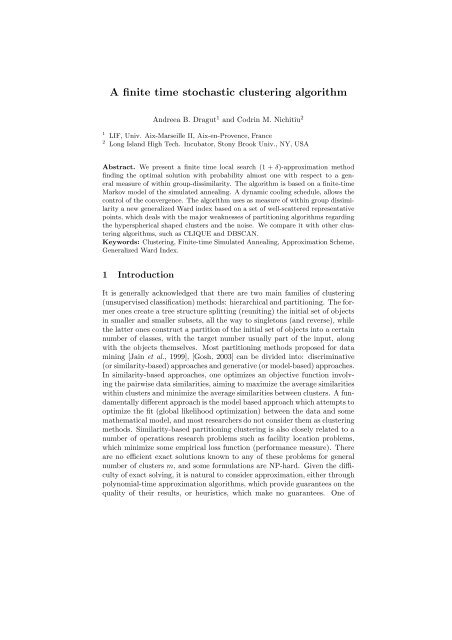
![Rapport de projet 3A IT et Mastère ISIC [pdf 260 ko]](https://img.yumpu.com/17470161/1/184x260/rapport-de-projet-3a-it-et-mastere-isic-pdf-260-ko.jpg?quality=85)


